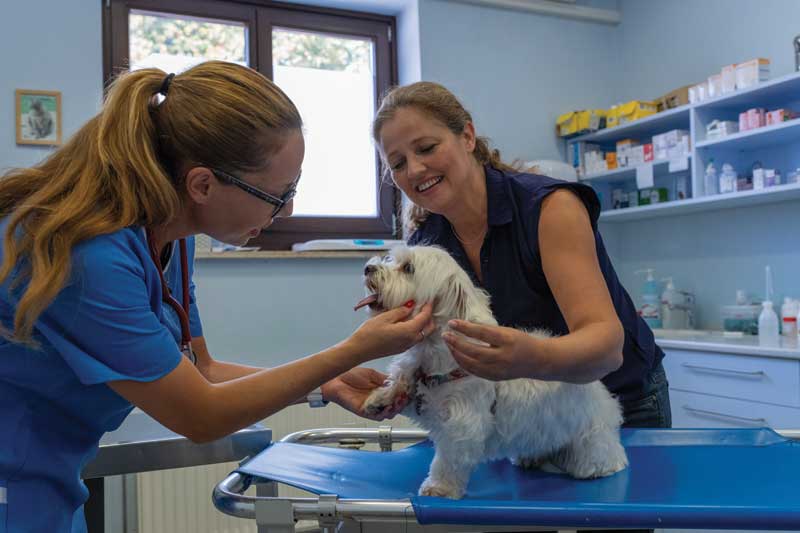
The chronic and incurable nature of most allergic and immune-mediated dermatoses in dogs and cats are frustrating for both owners and veterinarians. In a 2010 study,1 it was found owners of pets with chronic skin disease, particularly atopic dermatitis, often have much lower quality of life scores compared to owners of pets without skin issues. Many of the factors that affect quality of life for these owners result from the effects of high caregiver burden.
Caregiver burden is the load or strain placed on a person who cares for a chronically ill, disabled, or elderly family member, including pets. Chronic caregiver burden has been shown to impact the veterinarian-client relationship due to increased stress and frustration during most communications, which often leads to burden transfer to the veterinarian and can affect the trust between both parties.2 Understanding caregiver burden and ways to overcome throughout the course of treatment is imperative for the successful management of most dermatological conditions.
There are five types of caregiver burden: physical, emotional, time-dependent, developmental, and social. The complexity of the treatment plan has been shown to have significant impact on the caregiver burden and owner quality of life.2 When formulating a treatment plan for long-term management of skin disease, these factors should be considered and reduced when able to help reduce caregiver fatigue and improve the quality of life of the owner and pet. Additionally, lessening of caregiver burden was shown to have a positive impact on the veterinarian-client relationship and improved owner compliance.2
1) Physical burdens
The most common causes of physical caregiver burden are related to the owner’s ability to physically complete the treatment recommendations, including: administering oral medications, applying otic medications, and frequent bathing or applying other topical products. It is important to understand an owner’s physical limitations as well as the pet’s limitations to help minimize physical caregiver burden.
- For oral medications, offering different formulations (i.e. liquid vs. pills) can be a simple method to help ease an owner’s frustration with frequent medicating. Additionally, offering tips or tricks or demonstrating how to medicate their pets can also help improve an owner’s confidence they can accomplish the recommended treatments. Finally, reducing any unnecessary supplements or vitamins may help streamline the process to make it feel more feasible.
- For otic medications, reducing any concurrent pain will help make the pet more tolerant of application and can help reduce the stress on owners. When appropriate, the use of long-acting otic medications that can be applied in office can greatly improve compliance and owner satisfaction by reducing the need to medicate the pet’s ears at home.
- Bathing is often beneficial for reducing allergen carriage, treating secondary bacterial or Malassezia infections, or reducing odor or scaling. However, it is a very time consuming and physically demanding process for many pet owners. Although topicals are often important components of a treatment plan for most common skin disease, they can place a huge burden on the owner. Discussing options with owners for alternative topicals such as sprays or mousses, reduction in the frequency of bathing, or discussing alternative options for bathing such as groomers may improve overall compliance and success of topical routines.
2) Emotional burdens
A study found owners of dogs with chronic skin disease can have reduced quality of life scores due to the physical exhaustion, mental weariness, social problems, family disagreements, and significant financial costs associated with treatment.3 Additionally, since skin disease is very visible to the owner, they experience a lot of guilt and stress from watching their pet suffer. Open and clear communication about the expectations and outcomes of treatment plans can help reduce the emotional burdens in these cases.
3) Time-dependent burdens
Time-dependent burdens arise from the stress secondary to the amount of personal time needed to care for the pet’s medical needs. Many of these burdens arise from timing of medications or length of treatments needed. The main time-dependent burdens in dermatology is the use of medications, particularly antibiotics, that have to be given multiple times a day, and the amount of time consumed with multifaceted topical regimens.
While topicals can play an important role in management of skin disease, evaluating the recommended frequency of otic flushing or bathing to balance the benefits of topical therapy and the owner workload is an easy way to streamline the treatment plan and reduce the amount of time the owner is required to spend on daily treatments.
When appropriate, using long-acting injectable antibiotics, such as cefovecin, or utilizing a more potent oral steroid, such as oral dexamethasone, which is dosed less frequently than prednisone, can also help reduce the treatment time required and help reduce the burden on the owner.

4) Social burdens
Social burdens often result from an owner feeling judged by family, peers, and veterinarians which can cause an owner to isolate the pet or themselves.2 Owners of pets with chronic skin disease often feel concerned about how the pet’s appearance is perceived and may avoid seeking help if they feel judged.2 This is a challenging burden to overcome, but empowering owners to advocate their concerns and reminding them of the ultimate goals for improvement in the physical appearance with a treatment plan can help reduce the social concerns.
5) Developmental burden
Developmental caregiver burdens arise when ta younger family member becomes the caretaker of an older family member shifting the family dynamics and preventing the normal developmental stages of the child. Due to the unique dynamics of developmental caregiver burdens, is rarely seen in
veterinary medicine.
Although the chronicity, complexity, and expense associated with the management most cutaneous disease process is often unavoidable, open communication and clear expectations can help avoid unnecessary stress and frustration within the care team. Addressing and reducing the numerous burdens associated with the long-term care plan necessary for treatment of most skin conditions can help improve the quality of life of the owner, the pet, and the veterinarian involved.
Rebecca Mount, DVM, DACVD, earned her Bachelor of Science in biology from the University of New Mexico in 2005, and her doctorate of veterinary medicine from Colorado State University College of Veterinary and Biomedical Sciences in 2009. Following graduation, Dr. Mount completed an internship in small animal medicine and surgery at Garden State Veterinary Specialist in New Jersey. She began her residency with Dermatology for Animals in 2010, and became a diplomate of the American College of Veterinary Dermatology in 2014.
References
- Linek, M., Favrot, C. Impact of canine atopic dermatitis on the health-related quality of life of affected dogs and quality of life of their owners. Veterinary Dermatology. 2010. (21): 456-462.
- Spitznagel, MB, Solc, M, Chapman, KR, et al. Caregiver burden in the veterinary dermatology client: comparison to healthy controls and relationship to quality of life. Veterinary Dermatology. 2019: (30) 3-e2.
- Noli C, Colombo S, Corneglianai L, et al. Quality of life of dogs with skin disease and their owners. Part 2: administration of a questionnaire in various skin diseases and correlation to efficacy of therapy. Veterinary Derematology. 2011 (22): 344-351
